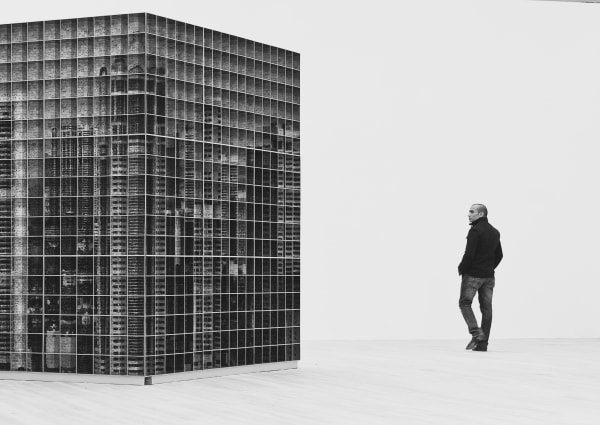-

-
We look forward to welcoming you to our booth J9 at Art Basel 2023. Highlights will include works by Anju Dodiya, Atul Dodiya, Jitish Kallat, Mithu Sen, N S Harsha, Rashid Rana, Reena Saini Kallat and Shakuntala Kulkarni.
-
ANJU DODIYA
-
-

-
ATUL DODIYA
-
-
In his latest series of oil paintings, Atul Dodiya reimagines scenes from Hindi and Bengali cinema from 1949 to 1971. In the two works presented at Art Basel, he spotlights frames from Padosan (1968), directed by Jyoti Swaroop, starring Sunil Dutt as Bhola and Saira Manu as Bindu. Dodiya’s frozen moments guide the eye to the decor in the scenes – period furniture, patterned vases, bookcases, console cabinets, statutes, vases, the radiogram, photographs and occasionally a piano. They evoke the image of home and life in post independence Indian cinema before the economic liberalization of 1991, when the influence of modernism and Deco aesthetics was rampant. The false interiors are celebrated, recreated in the tonal quality similar to the celluloid colour of films from this era. Layers of paint are applied in rough impasto, heavily loaded in thick pastel hues, pinks, turquoise and pale blues. Both characters’ faces remain hidden; Dodiya flattens and blends them into the settings, taking the focus off the actors and imbuing a sense of mystery in the cinematic moment.
-
JITISH KALLAT
-
-

-
MITHU SEN
-
-

-
N S HARSHA
-
 N S HarshaAscent or Descent to Reality, 2018Bamboo, cloth, iron, wooden clips, acrylic colour, and steel strings113.3 x 170.8 x 19 in
N S HarshaAscent or Descent to Reality, 2018Bamboo, cloth, iron, wooden clips, acrylic colour, and steel strings113.3 x 170.8 x 19 in
288 x 434 x 48.5 cmAscent or Descent to Reality came from N S Harsha’s observation of a common landscape in Hong Kong, when he saw rows of laundry hanging outside on the balconies of public housing estates. Ascent or Descent to Reality consists of layers of cosmic paintings, painted fabrics, and a bamboo ladder. The materials used for the cosmic paintings are black cotton fabrics. In the middle of these layered paintings, a bamboo ladder is installed horizontally with golden leaf applied on one end of the ladder, while the rest of the ladder remains bare. In this regard, ascent can be perceived as the absolute truth or ideal, as the gold leaf implies, whilst descent may represent our real life and physical reality, which has yet to reach the absolute truth. However, in this work, the ladder is fixed horizontally, resulting in a questioning and obscuring of the hierarchical order between upward and downward.
-
-
RASHID RANA
-

-
REENA SAINI KALLAT
-
Pattern Recognition draws attention to the ever-shifting, yet perpetually unequal politics of access and mobility worldwide. Appropriating the format of Snellen charts - typically used to test vision - Reena Kallat presents two pyramidical representations featuring maps of different countries. The charts are based on data from Henley's Passport Index, which ranks nations on the strength of their passports, determined by the travel freedoms granted to their citizens. The chart on the left represents data from 2006, while the one on the right reflects statistics from 2023. The maps of countries with visa-free travel to more regions are larger and placed higher on the charts, while countries with more travel restrictions appear below in smaller scale. The comparison between the two charts reveals a change in power dynamics, as maps of Denmark and other European nations previously at the top are replaced with Asian countries like Japan, Singapore and South Korea, rising in rank. However, the gap between countries with the highest and lowest mobilities remains significant in both charts, suggesting persistent global travel imbalance. While national borders appear recurrently in Kallat’s practice, Pattern Recognition expands the conversation to encompass privilege and policy. Despite the perception of a globally interconnected world, physical constraints and bureaucratic measures continue to reinforce inequalities and impede mobility.
-
SHAKUNTALA KULKARNI
-
-
Shakuntala Kulkarni often revisited the oeuvres of the well known Japanese designers, Rei Kawakubo and Yohji Yamamoto, and went back to several of their early collaborations. In one of their Paris shows, she was stunned by their use of black. Sharp forms, sometimes bulging, sometimes ballooned - they felt as if floating in space. The black charcoal came to instant rescue aiding the costumes that her women began to dress in – with their dark, dense, and heavy shapes, creating an opacity that felt unexpected and joyful in their 'non-colour'. She then began to look at hairstyles –from Freida Kahlo, hairdos from old Biblical images, ancient Roman, Greek to the woman on the street that she saw daily whose unwashed hair created its own matted style that haute couture models would find hard to imitate: hair became an imperative statement in Kulkarni’s parade. In her latest series Stuck in the shadow - she began by drawing the bodies of women who had passed their prime - bodies that made new shapes: sagging breasts, stomachs swelled – the charcoal along with the space the large white sheets provided, allowed for voluminous forms. Here, strange bodies are caught in moments where they are about to topple: almost falling out of their own shadows, only to be saved by their sense of balance.
-
Explore booth artists


















